Last Friday (December 5, 2025), I filmed an extended discussion with my Kyoto University colleague,…
Australia – wage data shows real wages continue to decline for the sixth consecutive quarter
Today (September 16, 2022), the Australian Bureau of Statistics released the latest – Wage Price Index, Australia – for the September-quarter, which shows that the aggregate wage index rose by 1 per cent over the quarter and 3.1 per cent over the 12 months. There was a major discrepancy between the private sector (1.2 per cent for the quarter) and the public sector (just 0.6 per cent), which reflects the harsh wage caps that the federal and state governments have in place that are undermining the well-being of public employees. While there has been some pickup in the pace of nominal wages growth, the fact remains that workers have endured another quarter of real cuts to the purchasing power of their wage. This is the sixth consecutive quarter that real wages have fallen. There can be no sustained acceleration in the inflation rate arising from wages growth under these circumstances. Further with the gap between productivity growth and the declining real wages increasing, the massive redistribution of national income away from wages to profits continues. The business sector, as a whole, thinks it is clever to always oppose wages growth and the banks love that because they can foist more debt onto households to maintain their consumption expenditure. None of this offers workers a better future.
There is no global wage-price spiral occurring
A period of inflation which is accompanied by rising nominal wages growth but systematic real wage cuts is not symptomatic of a wage-price spiral.
The Financial Times recently published the following graphic:
I saw a Tweet this morning which attached this graphic and wrote “The dreaded ‘wage-price spiral’ takes hold”.
This only served to demonstrate how little the commentator knew about wage-price or price-wage dynamics.
You don’t get a ‘wage-price’ propagation mechanism operating in a period where real wages are being systematically reduced by rising inflation, sourced from mainly supply-side factors.
Latest Australian data
The Wage Price Index:
… measures changes in the price of labour, unaffected by compositional shifts in the labour force, hours worked or employee characteristics
Thus, it is a cleaner measure of wage movements than say average weekly earnings which can be influenced by compositional shifts.
The summary results (seasonally adjusted) for the September-quarter 2022 were:
| Measure | Quarterly (per cent) | Annual (per cent) |
| Private hourly wages | 1.2 | 3.4 |
| Public hourly wages | 0.6 | 2.4 |
| Total hourly wages | 1.0 | 3.1 |
| Basic CPI measure | 1.8 | 7.3 |
| Weighted median inflation | 1.4 | 5.0 |
| Trimmed mean inflation | 1.8 | 6.1 |
On price inflation measures, please read my blog post – Inflation benign in Australia with plenty of scope for fiscal expansion (April 22, 2015) – for more discussion on the various measures of inflation that the RBA uses – CPI, weighted median and the trimmed mean The latter two aim to strip volatility out of the raw CPI series and give a better measure of underlying inflation.
Real wage trends in Australia
The summary data in the table above confirm that the plight of wage earners continues in Australia.
Real wages fell again in the September-quarter in both the private and public sectors.
It is clear that the public sector wage caps (state and federal) have created an environment where private sector wage rises are being constrained, independently of the state of the private labour market.
The first graph shows the overall annual growth in the Wage Price Index (public and private) since the September-quarter 2000 (the series was first published in the September-quarter 1997) and the RBA’s core annual inflation rate (red line).
Any blue bar area above the red line indicate real wages growth and below the opposite.
Workers have endured increasing real wage cuts over the last six quarters.
The next graph shows the growth in private sector real wages since the September-quarter 2005 to the September-quarter 2022. The core inflation rate is used to deflate the nominal wages growth.
The blue bars are the annual rate of change, while the red line is the quarterly rate of change.
The fluctuation in mid-2020 is an outlier created by the temporary government decision to offer free child care for the September-quarter which was rescinded in the September-quarter of that year.
Overall, the record since 2013 has been appalling.
Throughout most of the period since 2015, real wages growth has been negative with the exception of some partial catchup in 2018 and 2019.
The systematic real wage cuts indicate that wages are not driving the inflationary episode. Workers are only able to secure partial offset for the cost-of-living pressures caused by the supply-side, driven inflation.
Industry Variability
The aggregate data shown above hides quite a significant disparity in quarterly wage movements at the sectoral level, which are depicted in the next graph.
The blue bars are the current quarterly change, while the red triangles are the previous quarterly change.
Some sectors have experienced rising nominal wages growth in the last quarter but many other sectors are static or going backwards.
It is no surprise that the construction sector is leading the way given the shortage of workers due to Covid.
The ABS also reported that:
- Jobs in the Health care and social assistance (1.5%) and Professional, scientific and technical services (1.7%) industries were the main contributors to growth reflecting both the size of these industries and the size of the wage increases.
- The Retail trade industry recorded the highest quarterly and annual growth at 2.4% and 4.2%, respectively. Industry growth was mainly driven by the size and timing of award rises, the higher annual rate of growth reflecting two award increases paid to jobs within the last year.
- he Education and training industry recorded the lowest quarterly (0.8%) and annual (2.2%) growth across all industries.
If we consider the situation over the last year, then we can see from the following graph that wages growth has picked up a bit but this is not demonstrative of any major wages breakout occurring.
While nominal wages growth was positive, albeit modest, the next graph shows the movements in real wages and you can see that real wages fell in all sectors.
This is now a chronic situation.
This on-going cut in the purchasing power of workers is almost unprecedented in our wages history and marks a massive redistribution of income towards profits.
Further, one can hardly say that wages push is causing the inflation spike.
The great productivity rip-off continues at a pace
While the decline in real wages means that the rate of growth in nominal wages being outstripped by the inflation rate, another relationship that is important is the relationship between movements in real wages and productivity.
Historically (up until the 1980s), rising productivity growth was shared out to workers in the form of improvements in real living standards.
In effect, productivity growth provides the ‘space’ for nominal wages to growth without promoting cost-push inflationary pressures.
There is also an equity construct that is important – if real wages are keeping pace with productivity growth then the share of wages in national income remains constant.
Further, higher rates of spending driven by the real wages growth can underpin new activity and jobs, which absorbs the workers lost to the productivity growth elsewhere in the economy.
Taking a longer view, the following graph shows the total hourly rates of pay in the private sector in real terms (deflated with the CPI) (blue line) from the inception of the Wage Price Index (September-quarter 1997) and the real GDP per hour worked (from the national accounts) (green line) to the September-quarter 2021.
It doesn’t make much difference which deflator is used to adjust the nominal hourly WPI series. Nor does it matter much if we used the national accounts measure of wages.
But, over the time shown, the real hourly wage index has grown by only 8.8 per cent (and falling), while the hourly productivity index has grown by 34.7 per cent.
So not only has real wages growth turned negative over the last year or so, but the gap between real wages growth and productivity growth continues to widen.
If I started the index in the early 1980s, when the gap between the two really started to open up, the gap would be much greater. Data discontinuities however prevent a concise graph of this type being provided at this stage.
For more analysis of why the gap represents a shift in national income shares and why it matters, please read the blog post – Australia – stagnant wages growth continues (August 17, 2016).
Where does the real income that the workers lose by being unable to gain real wages growth in line with productivity growth go?
Answer: Mostly to profits.
The next graph shows the gap between the real wage index and the labour productivity index in points.
It provides an estimate of the cumulative redistribution of income to profits as a result of real wage suppression.
Now, if you think the analysis is skewed because I used GDP per hour worked (a very clean measure from the national accounts), which is not exactly the same measure as labour productivity, then consider the next graph.
It shows the movements in the wage share in GDP (at factor cost) and profit share since the September-quarter 1960 to the June-quarter 2022 (latest data).
While the series move around from quarter to quarter, the trend is obvious.
The only way that the wage share can fall like this, systematically, over time, is if there has been a redistribution of national income away from labour.
I considered these questions in a more detailed way in this blog post series:
1. Puzzle: Has real wages growth outstripped productivity growth or not? – Part 1 (November 20, 2019).
2. 1. Puzzle: Has real wages growth outstripped productivity growth or not? – Part 2 (November 21, 2019).
And the only way that can occur is if the growth in real wages is lower than the growth in labour productivity.
That has clearly been the case since the late 1980s. In the September-quarter 1991, the wage share was 56.6 per cent and the profit share was 22.2 per cent.
By the September-quarter 2022, the wage share had fallen to 48.5 per cent and the profit share risen to 32.9 per cent.
There has been a massive redistribution of income towards profits has occurred over the last 40 years.
The relationship between real wages and productivity growth also has bearing on the balance sheets of households.
One of the salient features of the neo-liberal era has been the on-going redistribution of national income to profits away from wages. This feature is present in many nations.
The suppression of real wages growth has been a deliberate strategy of business firms, exploiting the entrenched unemployment and rising underemployment over the last two or three decades.
The aspirations of capital have been aided and abetted by a sequence of ‘pro-business’ governments who have introduced harsh industrial relations legislation to reduce the trade unions’ ability to achieve wage gains for their members. The casualisation of the labour market has also contributed to the suppression.
The so-called ‘free trade’ agreements have also contributed to this trend.
I consider the implications of that dynamic in this blog post – The origins of the economic crisis (February 16, 2009).
As you will see, I argue that without fundamental change in the way governments approach wage determination, the world economies will remain prone to crises.
In summary, the substantial redistribution of national income towards capital over the last 30 years has undermined the capacity of households to maintain consumption growth without recourse to debt.
One of the reasons that household debt levels are now at record levels is that real wages have lagged behind productivity growth and households have resorted to increased credit to maintain their consumption levels, a trend exacerbated by the financial deregulation and lax oversight of the financial sector.
Real wages growth and employment
The standard mainstream argument is that unemployment is a result of excessive real wages and moderating real wages should drive stronger employment growth.
As Keynes and many others have shown – wages have two aspects:
First, they add to unit costs, although by how much is moot, given that there is strong evidence that higher wages motivate higher productivity, which offsets the impact of the wage rises on unit costs.
Second, they add to income and consumption expenditure is directly related to the income that workers receive.
So it is not obvious that higher real wages undermine total spending in the economy. Employment growth is a direct function of spending and cutting real wages will only increase employment if you can argue (and show) that it increases spending and reduces the desire to save.
There is no evidence to suggest that would be the case.
I usually publish a cross-plot that consistently shows no relationship between annual growth in real wages and the quarterly change in total employment over a long period.
The graph has issues at present due to Covid-19 outliers, although the conclusion doesn’t change.
There is also strong evidence that both employment growth and real wages growth respond positively to total spending growth and increasing economic activity. That evidence supports the positive relationship between real wages growth and employment growth.
Conclusion
In the September-quarter 2022, Australia’s wage growth remained well below that necessary to restore the purchasing power losses arising from price level inflation.
The data shows that the significant cuts to workers’ purchasing power continue, and, in my view, constitute a national emergency.
There can be no sustained acceleration in the inflation rate arising from wages growth under these circumstances.
Further with the gap between productivity growth and the declining real wages increasing, the massive redistribution of national income away from wages to profits continues.
The business sector, as a whole, thinks it is clever to always oppose wages growth and the banks love that because they can foist more debt onto households to maintain their consumption expenditure.
None of this offers workers a better future.
That is enough for today!
(c) Copyright 2022 William Mitchell. All Rights Reserved.

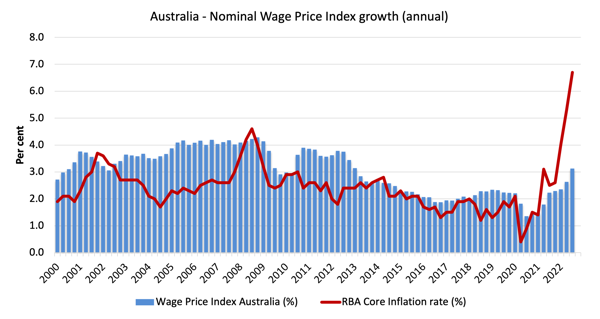
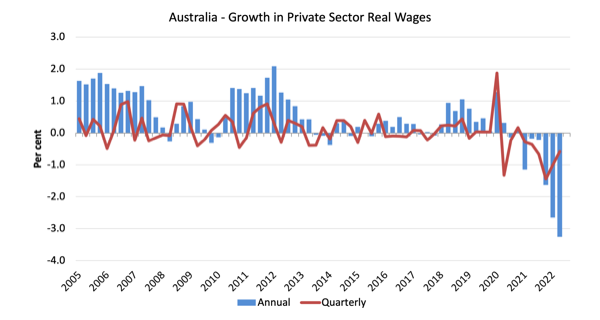
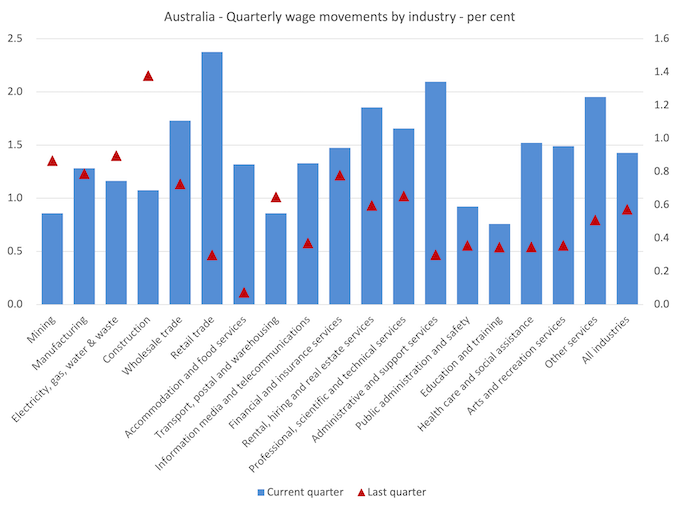
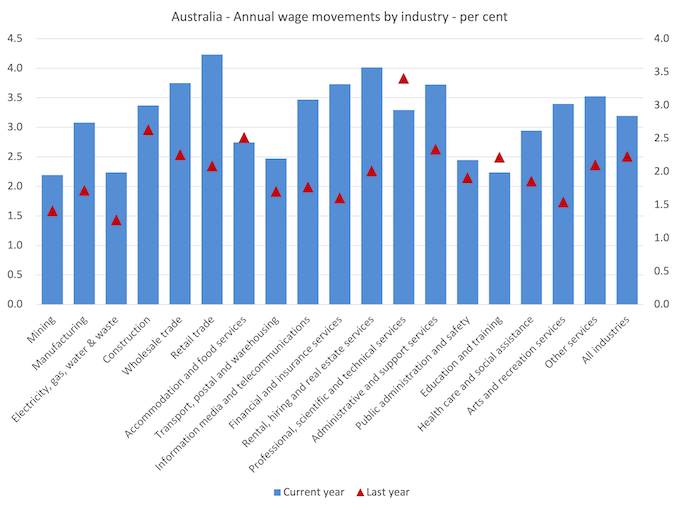
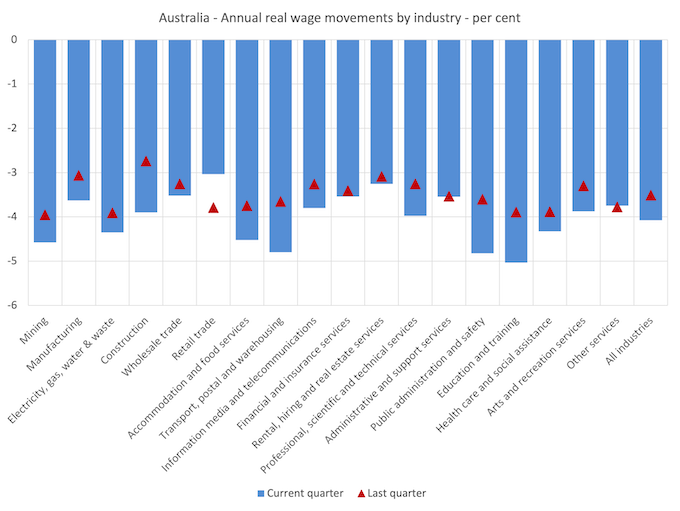
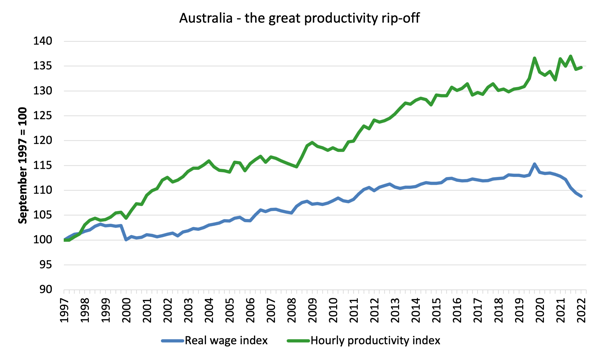
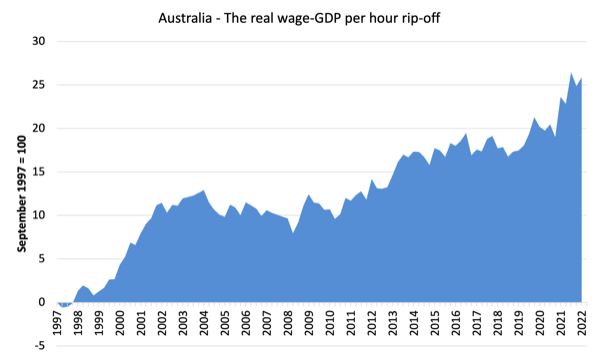
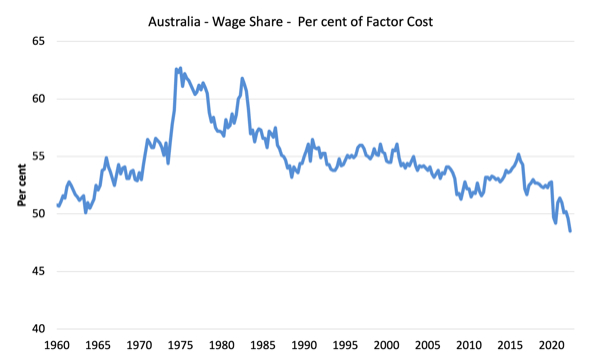

Thanks bill…I was looking for a response to Philip’s claims about the supposed wage price spiral. He also posted a follow up about how progressives think there is no wage-price spiral simply because real wages are declining, which he says is wrong.
@Charlie
I think the two graphs showing recent changes in wage and profit shares of factor costs are a pretty conclusive rebuttal of the argument in the FT article. The only thing wages are spiraling is the drain.
At least at the federal level there are signs that wages are coming out of the deep freeze.
I note the “Public Sector Interim Workplace Arrangements” published 6 October 2022, in which the APS is instructed that “interim arrangements should be adjusted to 3.00%”.
The “housing crisis” in Australia also has a blame game; Local Govt imposing strict DA requirements, State Govt not releasing land, not building infrastructure to service undeveloped land etc.
No doubt these factors contribute.
But one factor we don’t discuss is a 25yr long disconnect between wages and profits that has created a generation of renters who simply don’t have sufficient income and income security to qualify for housing loans.
They’re not building new homes, or buying existing homes so we’ve become over-reliant on investors for new housing stock.
Rentals as a % of residential properties has nearly doubled to 30% over 25 yrs.
Finance Minister Cormann proudly described downward flexibility in the rate of wage growth as a deliberate design feature of economic policy.
The ABS report that in 2023 the median income is $59k, so that’s 6.7mio wage earners that bring in somewhere between a few hundred dollars per year and the highest earner in the bottom half is scraping by on $59k.
Christ on a bike, surely none of this cohort is contemplating building a new home.
There was a time when an ordinary person on an ordinary wage could buy a block of land and have an ordinary home built on it.
Housing construction boomed.
The increasing disparity between wealth and income is as Cormann says an outcome of economic policy. Surely, this needs to be corrected if the ordinary Aussie is to become a home-owner again and as a consequence of their own action, stimulate housing construction and help alleviate the housing crisis.